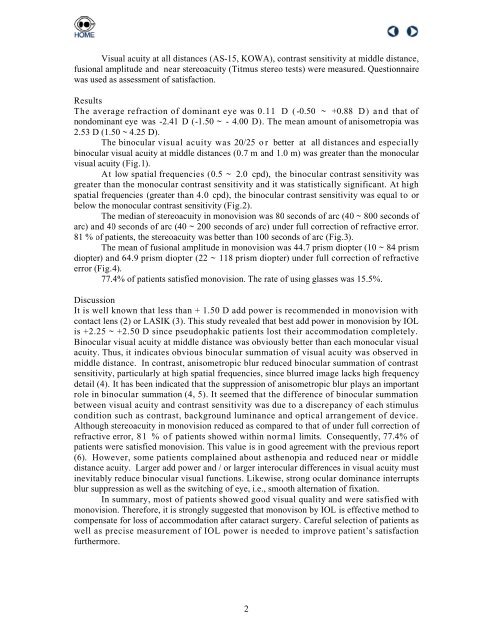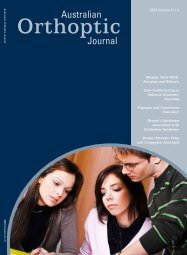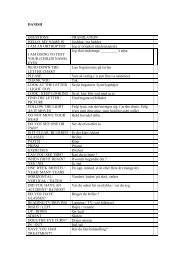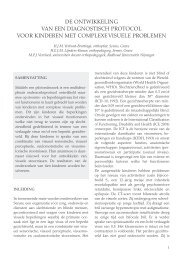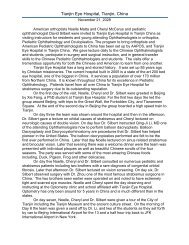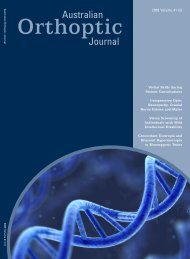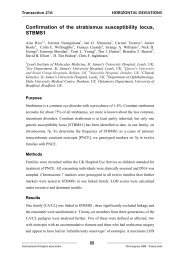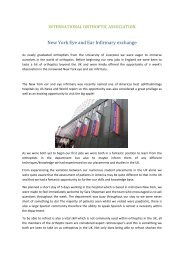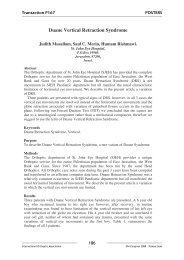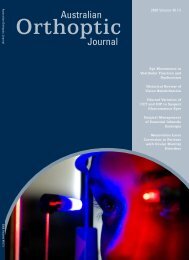Transactions from the Xth International Orthoptics Congress 2004
Transactions from the Xth International Orthoptics Congress 2004
Transactions from the Xth International Orthoptics Congress 2004
Create successful ePaper yourself
Turn your PDF publications into a flip-book with our unique Google optimized e-Paper software.
Visual acuity at all distances (AS-15, KOWA), contrast sensitivity at middle distance,<br />
fusional amplitude and near stereoacuity (Titmus stereo tests) were measured. Questionnaire<br />
was used as assessment of satisfaction.<br />
Results<br />
The average refraction of dominant eye was 0.11 D (-0.50 ~ +0.88 D) and that of<br />
nondominant eye was -2.41 D (-1.50 ~ - 4.00 D). The mean amount of anisometropia was<br />
2.53 D (1.50 ~ 4.25 D).<br />
The binocular visual acuity was 20/25 or better at all distances and especially<br />
binocular visual acuity at middle distances (0.7 m and 1.0 m) was greater than <strong>the</strong> monocular<br />
visual acuity (Fig.1).<br />
At low spatial frequencies (0.5 ~ 2.0 cpd), <strong>the</strong> binocular contrast sensitivity was<br />
greater than <strong>the</strong> monocular contrast sensitivity and it was statistically significant. At high<br />
spatial frequencies (greater than 4.0 cpd), <strong>the</strong> binocular contrast sensitivity was equal to or<br />
below <strong>the</strong> monocular contrast sensitivity (Fig.2).<br />
The median of stereoacuity in monovision was 80 seconds of arc (40 ~ 800 seconds of<br />
arc) and 40 seconds of arc (40 ~ 200 seconds of arc) under full correction of refractive error.<br />
81 % of patients, <strong>the</strong> stereoacuity was better than 100 seconds of arc (Fig.3).<br />
The mean of fusional amplitude in monovision was 44.7 prism diopter (10 ~ 84 prism<br />
diopter) and 64.9 prism diopter (22 ~ 118 prism diopter) under full correction of refractive<br />
error (Fig.4).<br />
77.4% of patients satisfied monovision. The rate of using glasses was 15.5%.<br />
Discussion<br />
It is well known that less than + 1.50 D add power is recommended in monovision with<br />
contact lens (2) or LASIK (3). This study revealed that best add power in monovision by IOL<br />
is +2.25 ~ +2.50 D since pseudophakic patients lost <strong>the</strong>ir accommodation completely.<br />
Binocular visual acuity at middle distance was obviously better than each monocular visual<br />
acuity. Thus, it indicates obvious binocular summation of visual acuity was observed in<br />
middle distance. In contrast, anisometropic blur reduced binocular summation of contrast<br />
sensitivity, particularly at high spatial frequencies, since blurred image lacks high frequency<br />
detail (4). It has been indicated that <strong>the</strong> suppression of anisometropic blur plays an important<br />
role in binocular summation (4, 5). It seemed that <strong>the</strong> difference of binocular summation<br />
between visual acuity and contrast sensitivity was due to a discrepancy of each stimulus<br />
condition such as contrast, background luminance and optical arrangement of device.<br />
Although stereoacuity in monovision reduced as compared to that of under full correction of<br />
refractive error, 81 % of patients showed within normal limits. Consequently, 77.4% of<br />
patients were satisfied monovision. This value is in good agreement with <strong>the</strong> previous report<br />
(6). However, some patients complained about as<strong>the</strong>nopia and reduced near or middle<br />
distance acuity. Larger add power and / or larger interocular differences in visual acuity must<br />
inevitably reduce binocular visual functions. Likewise, strong ocular dominance interrupts<br />
blur suppression as well as <strong>the</strong> switching of eye, i.e., smooth alternation of fixation.<br />
In summary, most of patients showed good visual quality and were satisfied with<br />
monovision. Therefore, it is strongly suggested that monovison by IOL is effective method to<br />
compensate for loss of accommodation after cataract surgery. Careful selection of patients as<br />
well as precise measurement of IOL power is needed to improve patient’s satisfaction<br />
fur<strong>the</strong>rmore.<br />
2


